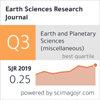Magnetic Petrology applied to the characterization of Pegmatite Dykes in Eastern Colombia
IF 0.5
4区 地球科学
Q4 GEOSCIENCES, MULTIDISCIPLINARY
引用次数: 0
Abstract
In the sector of San Jose, Macanal, and Tabaquen, in eastern Colombia, granitic rocks cut by pegmatite dikes and quartz veins appear with the presence of magnetite, ilmenite, and ilmenorutile. Using magnetic petrology and geochemistry concepts and methods, the main objective is to determine if these types of rocks are genetically related and how the fluid chemically evolves during its crystallization and cooling. This work was conducted in three stages. Petrography and opaque metallography for identifying the occurrence, paragenesis, and secondary processes that transform the oxides. In a second stage and utilizing an Electron Probe Microanalyzer (EPMA), 214 quantitative analyses (WDS) and four compositional maps for magnetite, ilmenite, and ilmenorutile were performed, measu- ring the oxides FeO, TiO2, V2O3, MgO, MnO, Nb2O5, Ta2O5, Al2O3, Ga2O3, NiO, CaO, Cr2O3, SnO, and WO3. Since magnetite and ilmenite are favorable geothermometers that also allow the calculation of oxygen fugacity, the ILMAT program was used to calculate these values. In closing, integrate the data with the magnetic susceptibility values. The results determine crystallization temperatures between 358-414 °C for the granitic-host rock and 402- 499 °C for pegmatites dykes, in a system where oxygen fugacity increases, the Mn2+ is enriched in the ilmenite, and magnetite preserves a low content of trace elements thorough the evolution of the fluid. Taken together with the martitization and exsolution of hematite and rutile within ilmenite found in the petrography, these results allow us to conclude that an oxide-silicate re-equilibration process controls the evolution of this magmatic-hy- drothermal fluid with a KUIlB cooling trend-type reaction. Based on the Al + Mn vs. Ti + V ratio, the signature of the magnetite is like the Lucky Friday mine’s signature studied by Nadoll. However, the analysis of the 95th percentile shows a different concentration of trace elements in the magnetite of both sectors. Therefore, a new field of discrimination is proposed for this environment of anorogenic pegmatites of the NYF family. Finally, the magnetic susceptibility is controlled only by the abundance of magnetite in each type of rock. The granitic host rocks have the highest susceptibility values, followed by pegmatites and quartz veins with the lowest.磁岩石学在东哥伦比亚伟晶岩岩脉表征中的应用
在哥伦比亚东部的San Jose、Macanal和Tabaquen地区,伟晶岩脉和石英脉切割的花岗岩出现了磁铁矿、钛铁矿和钛铁矿。利用磁性岩石学和地球化学的概念和方法,主要目的是确定这些类型的岩石是否具有遗传相关性,以及流体在结晶和冷却过程中是如何化学演化的。这项工作分三个阶段进行。岩石学和不透明金相学,用于确定氧化物的发生、共生和转化的二次过程。在第二阶段,利用电子探针微分析仪(EPMA),对磁铁矿、钛铁矿和钛铁矿进行了214次定量分析(WDS)和四次成分图谱,测量了氧化物FeO、TiO2、V2O3、MgO、MnO、Nb2O5、Ta2O5、Al2O3、Ga2O3、NiO、CaO、Cr2O3、SnO和WO3。由于磁铁矿和钛铁矿是有利的地热计,也允许计算氧逸度,因此使用ILMAT程序来计算这些值。最后,将数据与磁化率值进行积分。结果确定了花岗岩主岩的结晶温度在358-414°C和伟晶岩脉的结晶温度402-499°C之间,在这个系统中,氧逸度增加,Mn2+在钛铁矿中富集,磁铁矿在流体的演化过程中保留了低含量的微量元素。结合岩石学中发现的钛铁矿中赤铁矿和金红石的马氏化和出溶,这些结果使我们能够得出结论,氧化物-硅酸盐再平衡过程通过KUIlB冷却趋势型反应控制了这种岩浆热液的演化。根据Al+Mn与Ti+V的比值,磁铁矿的特征与Nadoll研究的Lucky Friday矿的特征相似。然而,第95百分位的分析显示,两个扇区的磁铁矿中微量元素的浓度不同。因此,对于NYF族非造山伟晶岩的这种环境,提出了一个新的判别领域。最后,磁化率仅受每种岩石中磁铁矿丰度的控制。花岗岩主岩的磁化率值最高,其次是伟晶岩和石英脉,磁化率值最低。
本文章由计算机程序翻译,如有差异,请以英文原文为准。
求助全文
约1分钟内获得全文
求助全文
来源期刊

Earth Sciences Research Journal
地学-地球科学综合
CiteScore
1.50
自引率
0.00%
发文量
0
审稿时长
>12 weeks
期刊介绍:
ESRJ publishes the results from technical and scientific research on various disciplines of Earth Sciences and its interactions with several engineering applications.
Works will only be considered if not previously published anywhere else. Manuscripts must contain information derived from scientific research projects or technical developments. The ideas expressed by publishing in ESRJ are the sole responsibility of the authors.
We gladly consider manuscripts in the following subject areas:
-Geophysics: Seismology, Seismic Prospecting, Gravimetric, Magnetic and Electrical methods.
-Geology: Volcanology, Tectonics, Neotectonics, Geomorphology, Geochemistry, Geothermal Energy, ---Glaciology, Ore Geology, Environmental Geology, Geological Hazards.
-Geodesy: Geodynamics, GPS measurements applied to geological and geophysical problems.
-Basic Sciences and Computer Science applied to Geology and Geophysics.
-Meteorology and Atmospheric Sciences.
-Oceanography.
-Planetary Sciences.
-Engineering: Earthquake Engineering and Seismology Engineering, Geological Engineering, Geotechnics.
 求助内容:
求助内容: 应助结果提醒方式:
应助结果提醒方式:


